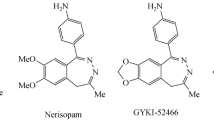Abstract
The reactions of the di(acid chloride) of 2-carboxy-3,4-dimethoxyphenylthiopyruvic acid with 1-aminoadamantane and with thiosemicarbazide take place with the closure of a seven-membered ring and the formation of 1,2-dihydro-(3H)-2-benzazepine-1,3-dione. On reaction with monochloroacetic acid, 4-mercapto-8, 9-dimethoxy-2-(N-thioureido)-1, 2-dihydro-(3H)-2-benzazepine-3-dione is converted into a derivative of thiazolidine-2,4-dione 2-hydrazone, which readily takes part in condensation reactions with oxo compounds forming 5-ylidene derivatives.
Similar content being viewed by others
Literature cited
M. S. Puar and B. R. Vogt, Tetrahedron, 34, 2887 (1978).
A. I. Scott, Experientia, 17, 68 (1961).
Author information
Authors and Affiliations
Additional information
Translated from Khimiya Geterotsiklicheskikh Soedinenii, No. 1, pp. 29–32, January, 1984.
Rights and permissions
About this article
Cite this article
Turkevich, N.M., Sementsiv, G.N. Derivatives of 2-benzazepine-1,3-dione. Chem Heterocycl Compd 20, 24–26 (1984). https://doi.org/10.1007/BF00505842
Received:
Issue Date:
DOI: https://doi.org/10.1007/BF00505842



